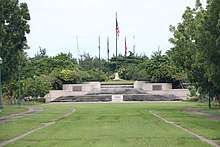Carolinian people
Carolinians are an Austronesian ethnic group who originated in Oceania, in the Caroline Islands, with a total population of around 8,500 people. They are also known as Remathau[1] in the Yap's outer islands.[2][3] The Carolinian word means "People of the Deep Sea." It is thought that their ancestors may have originally immigrated from Asia and Indonesia to Micronesia around 2,000 years ago. Their primary language is Carolinian, called Refaluwasch by native speakers, which has a total of about 5,700 speakers. The Carolinians have a matriarchal society in which respect is a very important factor in their daily lives, especially toward the matriarchs. Most Carolinians are of the Roman Catholic faith.
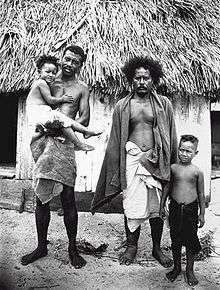 Carolinian family in 1915 | |
| Total population | |
|---|---|
| Over 8,500 | |
| Regions with significant populations | |
| Saipan, Northern Mariana Islands, Caroline Islands, Guam | |
| Languages | |
| Carolinian | |
| Religion | |
| Predominantly Roman Catholic and Traditional religions |
The immigration of Carolinians to Saipan began in the early 19th century, after the Spanish killed most of the local population of Chamorro natives, reducing them to just 3,700. They began immigrating by sailing mostly from small canoes via islands which were previously devastated by a typhoon. The Carolinians have a much darker complexion than the native Chamorros.
Genetics
Carolinians from Saipan have the same lineages with Remathau on the outer islands of Yap.
Some of the people on the islands are Chamolinians which are a mixture of Chamorro and Carolinian heritage.[4]
The Carolinians in the CNMI have a high rate of macrosomia which is where the infant is born abnormally large.[5]
History
The people have a long history from Caroline Islands and CNMI too the present in the 21st century.
Pre-spanish era (antiquity-1697)
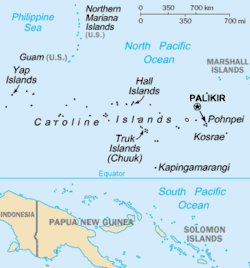
They have a history stretching back over 3000 years. The Carolinian people had contact with the Chamorro people for years. They had a long history of traveling from the Caroline Islands to what is now Guam. "Pre-contact" Carolinian designed pestles, hooks for fishing, and rings made out of shells found on the ground and beneath it show contact between the two groups.
They built canoes that would have a small roof. The roof only went over less than half of the canoe. The sides could be different colors. The boat could fit over 9 adults in it.[6]
Centuries ago they used sea-lanes based off memorized information from the prior generation.[7]
Before colonial times a system called sawei was practiced. The word sawei means Yapese chief, conqueror, tyrant. This involved the Carolinians gathering once every two or three years in Yap. This system may have existed before the year 1600. More on this is discussed in the religion section.
Trade between the two groups went on even during the Spanish occupation of Guam.
Typhoon devastation and spanish era (1697–1899)
In the late 1600s leprosy was present in the Marianas. The Spaniards tried to deal with this by quarantining lepers to Saipan and Tinian. These islands were isolated. Spaniards brought Carolinians to these islands to help the hospitals holding the patients with leprosy.[8]
Chamorro sargento mayor Luís de Torres became an important source for people who wanted information of the Carolinian people.
During this time the people built a boat called Waa (canoe). This is a boat built for the sea. They were for transporting cargo and passengers over long distances.[9]
In Guam, Carolinians came to Talofofo Bay in 1788. They were on a voyage. The reason why they stopped there was because they wanted iron. This kind of trade hadn't occurred in over a hundred years in Guam since the military conflicts between Spanish and Chamorros.
.jpg)
In the 19th century the Refaluwasch moved from Elato and Satawal islands in the East and West part of the Carolinian islands[10] to what is now Northern Mariana Islands.[11]
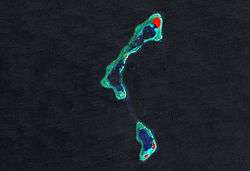
.jpg)
The two islands were destroyed by typhoon. Refaluwasch were starving during this time. Chief Nguschul of Elato along with Chief Aghurubw of Satawal led the people to the NMI. They landed at Micro Beach.[12] After coming to Saipan they built a village called Arabwal. Right now this area is in American Memorial Park.[13] This was not the only village built. The other one Ppiyal Oolang.[14] This area is where Nguschul and his group settled. The Carolinians continued to come here in the 100s as well as other areas such as Guam and Tinian.[15]
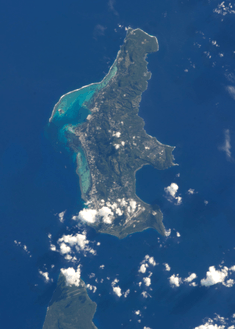
The Spanish allowed them to keep their culture.
During the mid 1800s Carolinians moved to Tamuning due to a 1849 typhoon which devastated their land.[16]
During this time they took over inter-island travel during the latter half of the 18th century and 19th century. They used a ship called banca to travel.
In 1865 265 Carolinians were transferred from the Carolines by Englishman George Johnston. He moved them to Pagan.[17]
The Tanapag village was setup by some Refaluwasch who left Tinian island in 1879.[17]
Ten years later in 1889 Governor Olive had the Refaluwasch on Tinian relocate to Tanapag.[17]
German period (1899–1914)
Spain sold the Northern Mariana Islands to Germany in 1899, after losing Guam to the United States in 1898. This area became known as the German Northern Marianas. This was the shortest period a country controlled this area. They didn't change the culture of the Carolinians a lot but did bring in new ways of schooling, bureaucracy, architecture, and administration.[18] The legal system was transparent towards both Carolinians and Chamorros.
Georg Fritz on 17 November 1899 became the first district officer of this area. He set up programs which brought the Carolinians and Chamorro people living on the islands together.
Marriages between German settlers or colonial officers and Carolinians at Saipan occurred. The marriage did not allow for citizenship for either the Carolinian partner or children. This was the same for Chamorro people.
Carolinians were peaceful towards the Germans.
The population measurement in 1901 for these individuals are 772. The last population count the Germans did in 1914 recorded 1,109 of them.[19]
Carolinians didn't own land during this time unlike the Chamorros living here.
US naval era (1899-1903)
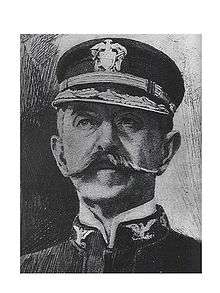
In Guam the people were made to adopt Western ways because of the U.S. Naval Administration.
One example of this was banning nudity. In Guam the first American governor was Richard P. Leary (1899–1900). He issued an order where Carolinian women in Guam weren't allowed to be naked when ever he visited. This was done away with by Governor William E. Sewell (1903–1904). The men were not allowed to be naked either. Many went to Saipan to avoid doing this. The constant nudity of the people bothered the second American governor Seaton Schroeder (1900–1903) so much that he decided to move them off the island. They were sent to CNMI through an agreement with the Germans who controlled those islands. They wanted additional laborers.
Japanese administration and occupation (1914–1945)
Japan took over the Mariana Islands in 1914. They were able to keep it due to the Treaty of Versailles.
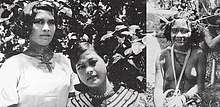
The Carolinians had villages which the Japanese called kanakas. These villages were controlled by sosoncho and soncho. Sosoncho is a general village chieftain. A soncho is a village chieftain. These chieftains didn't always have position under the traditional tribal patterns.
While the Japanese controlled these islands they used these people as laborers for mining and handling phosphate ore. One of the mines was in Angaur under the Palau group.[15] Carolinians were not treated as well as the Chamorros who worked with them. The Japanese and other colonial powers during this time (WWI-WWII) would not allow Carolinians to do canoe navigation over large distances.[22] During this time a term was used to refer to the Micronesian people under Japanese control which was 'Tomin.' Tomin meant inhabitants of the land. The Carolinian and Chamorro people viewed this as a put down since Japanese used it as part of discrimination. The people were kept under strict surveillance.[23] They were enslaved in 1944.[22] During this time few in this indigenous community served as scouts for the U.S. military. They served in the U.S. Marines.
On Saipan some Refaluwasch families were under an American military government. Some of them were in Camp Susupe. They were in a Chamorro-Carolinian area of the Camp.[24]
- The camp was used for Refaluwasch people as well as Japanese.
Some Refaluwasch were restricted from returning to their lands during this occupation. One of the reasons why they were interned was because the United States government wanted them to learn English as well as American political and social life. They were allowed to farm and fish before the evening. They had to return to the Camp when night came.
On Saipan during April 1945 there were 810 Refaluwasch on the island. Later in September of that more people of that group were brought into Saipan.[17]
After the Japanese surrender Refaluwasch were allowed to return to their lands.
Post world war ii (1945–present)
The people didn't object to the edicts of the U.S. military authorities. They were thankful for the basic necessities provided by Naval Military Government. The authorities founded a police force consisting of Carolinians and Chamorros for Camp Susupe and Chalan Kanoa. It was called Native Police and was 87 strong.[25]
Under the Naval Military Government Carolinian families in certain cases adopted orphans of Korean or Japanese descent. They were orphaned because of WWII.[24]
They have served in the Vietnam War. Only less than a 100 are known.
Before 2004 the Carolinians and Chamorro people were competing with each other before banding together. This is sometimes called Chamolinian. They did this to challenge what they call outsiders. Outsiders involve Filipinos and Japanese among other groups of immigrants and/or migrants.[26]
As of 2018 Refaluwasch in the Marianas have one of the highest rates of service in the U.S. military.
In 2018 former Acting Governor of Northern Mariana Islands Victor Hocog signed a proclamation to make September Chamorro and Carolinian Heritage Month. In the month you have special day called Chief Aghurubw Day. The former is held on 29 Sept.. Chief Aghurubw and his people travel from Satawal to Saipan before setting up the first Carolinian settlement in CNMI in 1815.
Population and economic figures
The population in 1999 on the CNMI was 3,500.
Carolinians due to Compact of Free Association have increased greatly on Guam. As of the 2000 U.S. census the population is around 11,000.
The Chamorros and Carolinians make up less than half of the people on CNMI.[27] They are 4.6% of the population on CNMI. According to the 2010 American FactFinder profile on CNMI the Carolinians number over 2,400.[28] In Saipan they are 20% of the population.[29] The population in the United States has increased a lot.[30] Outside the CNMI and Guam in the United States Washington State has the biggest population of them.[31] The population in the state is 127. In Seattle there is 116 of them.[31] Concerning age 40% of the people in this group are less than 18 while only 2% of this group are over 65.[31]
During the late 1990s it was estimated they had 20 percent unemployment. Also during this time they were behind the Chamorros in terms of economics. The Chamorro people were more economical development than they were. This has been going on for a long time in their community. They were susceptible to progress' bad effects.[32]
According to the 2010 U.S. Census the people along with other Micronesian groups have lower home owner ship than the many other ethnic groups in the country. They are mainly renters.[31] Their household sizes are 3.9. They have bigger household sizes than Latinos. Only 14% of them are homeowners while the rest are renters.[31]
Resistance to u.s. militarization
Despite the fact there are high rates of service for the military in this community there has been resistance to buildup.[35][36] Refaluwasch women are using different ways to resist military buildup in the Marianas Archipelago. They have used digital, legal, political, and spiritual methods to resist this. They are using lawsuits supported by the National Environmental Protection Act. They are using this against the Department of Defense (DoD) and Department of the Navy.
Politics
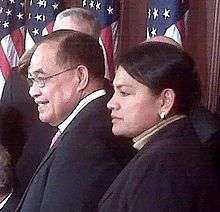
There has been efforts to bring the Marianas together. In the 1960s people submitted a resolution against putting the Marianas under one government. The Carolinians in the Northern Marianas desired stronger ties with Refaluwasch abroad in Micronesia.[37] A lot of them wanted CNMI to be freely associated with the U. S.
The population is represented in the legislature however the Chamorro people are dominant in politics.[38]
Elias Parung Sablan became Mayor of Saipan in 1945.
Benigno R. Fitial (1945– ) became the CNMI's first governor of Carolinian descent.[39]
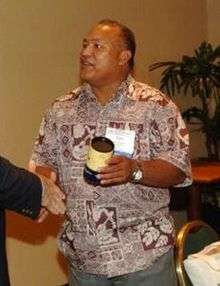
Lieutenant Governor Timothy P. Villagomez served under Fitial.[40][41]
Cinta Kaipat served in CNMI House of Representatives in the 15th CNMI Legislature.
Joseph James Norita Camacho was a member of 16th CNMI House of Representatives and held the position as House Floor Leader. He was elected to this position in 2007.
In the Obama Administration a Refaluwasch women named Rellani Bennett Ogumoro served as the Policy Advisor for the Domestic Policy Council.[42][43][44][45]
Culture
Their culture originated from the islands Yap and Chuuk in what is now the Federated States of Micronesia. The present day generation as of 2010 has less respect for the culture in addition to the chiefs who push them. The culture has been influenced by others who reside in CNMI.[46]
Cultural facts
The Managaha Island[47] is sacred in Refaluwasch culture due to the fact Chief Aghurubw is buried there.
Respect in their culture is very important like that of the Chamorro people. The Refaluwasch have respect for elders of any economic background. They have respect for elders of any education level.[48]
In the history of their culture there is a concept called tipiyeew. This means solidarity.
Mwei-mwei is a Refaluwasch way of adopting children. Its done between family members most of the time. Its initiated by females. This usually done by wives. The children adopted are usually babies but can be nine, ten, or eleven years old. The natural parents must give permission. After permission is given and the child is adopted the parents who take in the child or children in this custom treat them like a natural child in all situations.
Dance
The people have different dances. There is a dance called Bwai which is a Refaluwasch women dance. A certain cases when males dance they wear large leaves around their necks and wear leaves around their heads.[49][50] There is also one for men. It was originally for warriors but spread to other men after the people came to the Mariana Islands.[51]
Traditional dress, art, and body art
Dress
The Carolinian people had to give up native dress for more modest Western clothing.
Women in different cases would wear a long skirt up to the bottom of their breasts.
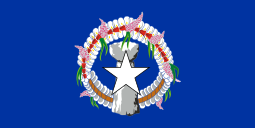
There is a wreath that's still worn call a mwar-mwar. Its still worn by many of them.
Body art
The female and males have their own tattoos. The females have tattoos are their lower thighs while the males have tattoos on their lower thighs as well as their upper thighs, buttock(s), arms, back of neck, and lower back.[52]
Art
They had a way of drawing(s).[53]
Death
When a person dies lots of sweet-smelling plants are placed all over the person's body. Flovers and vines are used to do this. The body is rolled up into pandanus mat. At the right time women place the body on the water and move it to the edge of a particular reef. The put weights with the dead person in the current which takes the body out to the ocean.
In their culture places called Fiirourow used to deal with people who passed. These are ancestral villages and places where the Refaluwasch go to burn the belongings of love ones. The places are located in the reefs.
Sometimes the body is burned and the ashes are 'return' to the ocean. In other cases the skull is put in sacred place. This is done for a spiritual reason.
Water
The water around the Northern Mariana Islands has been integral to these people. They have respect and connection to the sea. In the culture men would go out and get food while women would prepare. The women would scale clean and scale fish. They have celestial navigation skills. They share with the Native Hawaiians and Chamorro people a common ancient origin and seafaring navigation achievements.
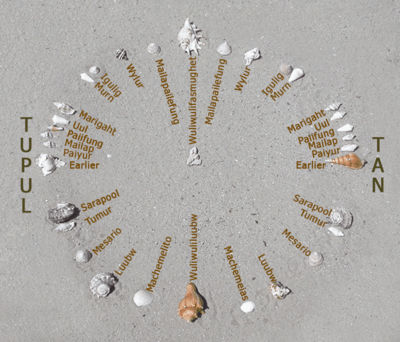
Carolinian customary law
Under this law property can be owned by one person or a whole family. The CNMI Code says family land should be held for the equal enjoyment of all members.
Traditional Carolinian land tenure involve women. Land was passed down from mother to daughter. The land was owned and controlled by women. The oldest female in the maternal line with the longest held title would be a "trustee" for the rest of the lineage members.
Food
Subsistence agriculture to get food was how these people lived from 1815 to 1914 in the CNMI.[54]
Seafood makes up a big part of their meat dishes. They have a history of fishing that goes over thousands of years.[55] Fishing trips are not just for feeding a small group of people but also for annual village parties, baptisms and confirmations, marriages, and other special celebrations. After fish are caught some of it may be given to the wife of the fisherman's family members as well as others.
In the past palu (navigators) brought food from the sea. They were respected.
Payúr is a fish that is caught using a poiu (fishing stone). Payúr is Refaluwasch for mackerel scad. Poiu consists of a limestone spherical sinker. Its smoothed into the shape of an egg. Holes are put into it. After this an inverted half coconut shell that's either the same size or a little smaller is connected with a cordage. Half of the coconut is filled with mashed or ground meat from a young coconut. This is similar to churn. This is to draw fish to it. This whole device is tied using a longer cord that's 50 or 60 feet in length. The cord is very long so that the poiu can be lowered into deeper water to feed fish. The poiu is set down on the sea bed before being moved closer to above the water over the course of a month. The Payúr are eventually gathered using a scoop net after getting to the surface.
One of the ways they prepare food involves using an uumw. Uumw is a traditional underground oven where you roasted food.
Language
This is a Chuukic language. The language has different versions. Carolinian is one of the official languages in the CNMI.
Written records of this language go back to the late 1700s.
For more information read the Carolinian language article.
Religion
Traditional religion(s)
Despite the Catholic faith many of them use land to talk to their ancestors. Land in their culture is not just "property." Its a spiritual matter. The place is where people can talk to their ancestors as well as collect unique properties for healing and teach traditions to future generations.
In their religion or religions they had i animas. Spiritual ancestors of the CNMI.
The ocean to these people is not just important to them its spiritual. According to some of them its spiritually central to Carolinian Indigeneity.
Before the Spanish brought Catholicism there was a religion where Supreme being called Yalafar was worshiped. There is also in this same religion an individual called Can who is a bad spirit.
After an individual dies in certain cases their skull is kept because some believe the spirit of the late relative can visit their family when necessary. The living have great respect for the dead. In their culture concerning their traditional religion(s) spirits of the dead can assist or hurt the living. It is also believed that since the spirit world is the source of all things in this world everything that lives or is real must be respected. They contain spirits which go by different names such as ghosts, taotaomo'na, white ladies, among other names.
As mentioned earlier they had a system called sawei. They would bring materials (offerings) to their "fathers" in exchange for "spiritual protection." One of the other reasons why people brought offerings was because of Yapese magicians. They were believed to have power over the weather.
The stick dance has a religious origin in Chuuk. It is claimed that a spirit taught this centuries ago during a war between two clans. The dance started off as a way of fighting.[51]
Roman catholicism
Roman Catholicism dominates in their societies. Due to Spanish missionary influence, they also use rosaries and novenas.
Efforts to bring Christianity to these people began with Father Paul Klein during the 1600s. One of the people to bring Catholicism to them was Father Juan Antonio Cantova in the early 1700s.
In 1819 a group of Carolinians was told to accept Christianity before moving to Saipan. The agreement (which included other things) was authorized by officials in Manila.
Family, gender, and health
Family
In 1999 domestic violence was said to be widespread.[32] Females are expected to treat male relatives with respect when they are present.
In their language there is a term called nemin. This endearment term is what the men use when referring to their partners.[51]
Gender
In this culture there are rigid gender divisions.[32]
When a male relative is in the same room a female may make herself lower than him. They may even get down on their hands and knees and crawl to where they have to go.[29]
Utt (pronounced "oot") is a meeting house where men congregate. They would also construct canoes in these places. In Garapan there is Carolinian Utt where you can play different sports. Its also used as a community center.[57]
Health
The Managaha Island is not only a sacred place but it has been used to get medicinal plants.[58]
According to the Asia Pacific Journal Public Health diabetes was more common among Carolinians in the 1990s.[59] In the community in 1999 they were dealing with drug abuse, alcoholism, and obesity. The main drug was crystal methamphetamine.[22]
The people are at an extremely high risk of getting two kinds of cancer. The two kinds are cervical and breast cancer. According to the Division of Public Health for recording Cervical cancer in 2005 the population for 25–34-year-old group 88.9 out of 100,000 gets this cancer. In the 35–44 group it is 49.4 out of every 100,000 for this disease. In the 45–54 its 40 per 100,000.
An article in Preventing Chronic Disease talked about births among Pacific Islanders in the CNMI. In the CNMI Carolinian mothers have a much higher risk of having a premature births than Chinese mothers. They are also more likely to have babies with macrosomia than Filipino moms. Out of all births from 2007 to 2014 this group is having the most children at 33.2%. Concerning teenage pregnancy its more common among them and other Pacific Islanders than other groups. They also have major issues with obesity and cholesterol. Diabetes is still an issue in their community. CNMI Pacific Islanders more so than other groups are engaging in unhealthy actions such as using tobacco, chewing betel nut, and consuming alcohol.[60] The chewing of betel nut is contributing to preterm birth rates among this.
Media
The Refaluwasch have little to no presence in films. Most films have white people in speaking roles. Pacific Islanders in Hollywood according to report from USC only make a fraction of the actors and actresses in film in recent years.[61]
They also have little to no presence in television. Pacific Islanders makeup a fraction of the characters on prime time. They makeup just 0.2% of acting roles where the character appears regularly. More than 64% of series as of 2017 did not feature a Pacific Islander or Asian American regularly. Their white counterparts will usually get three times the screen time they get in the same program.[62]
Comic strips in the early 20th century and 19th century had little to no female Refaluwasch whether they be cartoonists or minor characters.[63]
Notable people
Chief Aghurubw (????-????) of the Ghatoliyool clan[64] and chief of Satawal brought the Refaluwasch in Satawal to CNMI in 1815.[65]
Chief Nguschul of Elato (a coral reef atoll consisting of three islands) brought his group to what is now CNMI in 1815 and named a village Ppiyal Oolang which in English means "beach view sky."
Former Mayor Elias Parong Sablan (1900–1968) became second mayor of Saipan in 1945 and served 3 four-year terms until 1957.[66][67] He was also Judge of Saipan's Community Court, Chairman of Saipan's Board of Education, Chief of Police, and member of Congress (Saipan's). The man also owned a grocery store.[68]

Mau Piailug (1932–2010) was a master navigator involve in using non-instrument wayfinding.
Larry Saralu was one of the most famous singers in the early Post World War II years.[69] He was Saipanese Carolinian.
Lino (Urushemeyoung) Mettao Olopai[70] (1940–) was responsible for maintaining the Carolinian culture.
Benigno Repeki Fitial (1945–) became the first Carolinian governor of CNMI in 2006 and served until 2013. During this time he was a member of the U. S. Republican Party.[71]
Candy Taman (1948– ) is a Chamorro-Carolinian recording artist who made Chamorro and Carolinian music. He formed a band called Local Breed with Frank "Bokonggo" Pangelinan. He would later rename it Tropocisette. He pioneered Chamorro music on CNMI.
The first Refaluwasch woman to become a lawyer was Jacinta (Cinta) Matagolai[72] Kaipat.
Joseph James Norita Camacho became the first Carolinian judge in CNMI.[73] He became a judge in 2011.
Sarilyn Ogumoro Escobar became the first Carolinian to be a commissioned officer in US Navy.[74]
References
- Pacific Students Media (1 June 2015), Remathau Graduation 2015, retrieved 8 May 2019
- "Essay 12: Pacific Islanders in the US and their Heritage: Making Visible the Visibly Absent (U.S. National Park Service)". nps.gov. Retrieved 3 May 2019.
- Falanruw. Marjorie V. C. & Ruegorang, Francis. Dynamics of an Island Agroecosystem Where to Now? U. S. Forest Service, n. d. https://www.fs.fed.us/psw/publications/falanruw/psw_2015_falanruw001.pdf
- VILAR, MIGUEL G.; CHAN, CHIM W; SANTOS, DANA R; LYNCH, DANIEL; SPATHIS, RITA; GARRUTO, RALPH M; LUM, J KOJI (2013). "The Origins and Genetic Distinctiveness of the Chamorros of the Marianas Islands: An mtDNA Perspective". American Journal of Human Biology. 25 (1): 116–122. doi:10.1002/ajhb.22349. ISSN 1042-0533. PMC 4335639. PMID 23180676.
- "Fetal macrosomia – Symptoms and causes". Mayo Clinic. Retrieved 21 May 2019.
- Todino, Junhan B. "Carolinian Affairs Office float leads parade competition" The Guam Daily Post,https://www.postguam.com/news/cnmi/carolinian-affairs-office-float-leads-parade-competition/article_ac0f5916-8e43-11e8-a718-d78243d7dab8.html
- Meleisea, Malama; Linnekin, Jocelyn (2 March 2004). The Cambridge History of the Pacific Islanders. Cambridge University Press. ISBN 9780521003544.
- "Lepers in the Mariana Islands During the Spanish Administration 1668–1898 & Addenda (1899–1949)". uog.edu. Retrieved 18 April 2019.
- Guampedia (1 October 2009), Waa (Canoe) of the Caroline Islands, retrieved 19 April 2019
- Ristroph, Elizabeth Barrett. "The Survival Of Customary Law In The Northern Mariana Islands." Chicago-Kent School of Law Illinois Institute of Technology. 2007 http://studentorgs.kentlaw.iit.edu/jicl/wp-content/uploads/sites/5/2014/01/Ristroph_customary_nmi.pdf
- Guampedia (6 October 2009), Talofofo Bay, retrieved 19 April 2019
- Variety, Marianas. "BC's Tales of the Pacific: Refaluwasch come to Saipan". Marianas Variety. Retrieved 17 May 2019.
- "A Living Legacy." NPS,https://www.nps.gov/amme/planyourvisit/upload/AMME_S2_interactive.pdf. Accessed 4 April 2019.
- Flood, Bo; Strong, Beret E.; Flood, William (2002). Micronesian Legends. Bess Press. ISBN 9781573061292.
- Riesenberg, Saul H. & Kaneshiro, Shiegeru. A Caroline Islands Script. Smithsonian Institution, n. d. https://repository.si.edu/bitstream/handle/10088/22111/bae_bulletin_173_1960_60_269-333.pdf?sequence=1&isAllowed=y
- Guampedia (6 October 2009), Carolinians, 1902, retrieved 18 April 2019
- Amesbury, Judith R. "What are all those people doing in that ecosystem?" Scientific and Statistical Committee Western Pacific Fishery Management Council, NOAA, n. d.https://www.pifsc.noaa.gov/media/news/mariana_archipelago_ecosystem_science_implementation_plan_workshop_amesbury.pdf
- "» POP Cultures: CNMI". guampedia.com. Retrieved 7 April 2019.
- Arif, Sigit Supadmo; Prabowo, Abi; Suprapto, Anjar; Kurniawan, Judy (1 March 2007). "Irrigation asset management plan: concept development and its implementation in Indonesia". Jurnal Keteknikan Pertanian. 21: 45–56. doi:10.19028/jtep.21.1.45-56. ISSN 0216-3365.
- Saipan, Mailing Address: P. O. Box 5198; Us, MP 96950 Phone:234-7207 x2002 Contact. "Photo Gallery – American Memorial Park (U.S. National Park Service)". nps.gov. Retrieved 14 April 2019.
- "Marianas Memorial" (PDF). National Park Service. 1 May 2019. Retrieved 15 May 2019.
- Collier, R. Navigating Modernity / The Carolinians, a tiny group of islanders on Saipan, in the western Pacific, have seen their ancient culture succumb to consumerism. As they try to salvage what they can of their past, they are helping to lead a cultural revival am. San Francisco Chronicle. 1999, https://www.sfgate.com/news/article/Navigating-Modernity-The-Carolinians-a-tiny-3774200.php
- Guampedia. "Marianas History Conference III – Part 3" issuu. 2018, https://issuu.com/guampedia/docs/mhc_iii_2017_3
- The Northern Mariana Islands Judiciary: A Historical Overview. http://www.justice.gov.mp/uploads/History_Book_-_ch1-4.pdf: Northern Marianas Judiciary Historical Society. 2011. ISBN 978-0-615-42762-1.CS1 maint: location (link)
- Variety, Marianas. "A Saipan Marine died". Marianas Variety. Retrieved 17 May 2019.
- Meleisea, Malama (2 March 2004). The Cambridge History of the Pacific Islanders. Cambridge University Press. ISBN 9780521003544.
- Oliver, John NMI Statw Public Library System LSTA Five-Year Plan 2013-2017https://www.imls.gov/assets/1/AssetManager/CNMIPlan2012.pdf IMLS. Joeten Kiyu Public Library
- Bureau, U. S. Census. "American FactFinder – Results". factfinder.census.gov. Archived from the original on 12 February 2020. Retrieved 10 May 2019.
- Guampedia. Chamorro Cultural Values Workshop-Summary Workshop Report. Guampedia, 2016, http://www.guampedia.com/wp-content/uploads/2016/03/Chamorro_Cultural_Values_Workshop.pdf
- Hixson, Lindsay, Hepler, Bradford B. & Kim, Myoung O. The Native Hawaiian and Other Pacific Islander Population: 2010. Census, May 2012, https://www.census.gov/prod/cen2010/briefs/c2010br-12.pdf
- EPIC & Asian Americans Advancing Justice. Native Hawaiians & Pacific Islanders A Community Of Contrasts 2014 In The United States. Empower PDI, 2014, https://www.empoweredpi.org/uploads/1/1/4/1/114188135/a_community_of_contrasts_nhpi_us_2014-1.pdf
- "Navigating Modernity / The Carolinians, a tiny group of islanders on Saipan, in the western Pacific, have seen their ancient culture succumb to consumerism. As they try to salvage what they can of their past, they are helping to lead a cultural revival am". San Francisco Chronicle. 7 March 1999. Retrieved 15 April 2019.
- "Australia – Oceania :: Palau — The World Factbook – Central Intelligence Agency". cia.gov. Retrieved 21 May 2019.
- Metzgar, Eric (November 2016). "Carolinian Voyaging In The New Millennium" (PDF). Micronesian Journal of the Humanities and Social Sciences. 5: 293–305.
- "Welcome to California State University Dominguez Hills | Kanopy". csudh.kanopy.com. Archived from the original on 17 April 2019. Retrieved 17 April 2019.
- "Fanohge Famalåo'an & Fan'tachu Fama'lauan". Issuu. Retrieved 17 April 2019.
- "» History of Efforts to Reunify the Mariana Islands". guampedia.com. Retrieved 16 May 2019.
- "Northern Mariana Islands | history – geography". Encyclopædia Britannica. Retrieved 15 May 2019.
- Variety, Marianas. "Refaluwasch gather to express support for Heinz". Marianas Variety. Retrieved 1 May 2019.
- Blogger, Cnmi (1 April 2007). ".: 1st Ever Carolinian Language Symposium April 18 & 19, 2007". '. Retrieved 18 May 2019.
- "Tim Villagomez OK'd to travel to PH". Saipan News, Headlines, Events, Ads | Saipan Tribune. 1 November 2018. Retrieved 18 May 2019.
- House, The Obama White (2 September 2016). "Indigenous Peoples: Voices from the White House". Medium. Retrieved 1 May 2019.
- "Sandra Day O'Connor College of Law". apps.law.asu.edu. Retrieved 3 May 2019.
- Navigating a Political Relationship: Indigenous and American in the Commonwealth of the Northern Mariana Islands. Arizona State University, n. d. https://asuevents.asu.edu/sites/default/files/rellaniogumoroll3.pdf
- "Welcome to Summer Law Clerk Rellani Ogumoro". Native American Rights Fund. 2 August 2019. Retrieved 3 July 2020.
- Fishing People of the North Cultures, Economies, & Management Responding to Change https://seagrant.uaf.edu/events/2011/wakefield-people/abstract-book.pdf UAF. 2011
- "Asian American Pacific Islander National Historic Landmarks Theme Study." NPS, n. d., https://www.nps.gov/subjects/tellingallamericansstories/upload/0000-Front-Matter.pdf
- Pacific Asia Inquiry https://www.uog.edu/_resources/files/schools-and-colleges/college-of-liberal-arts-and-social-sciences/pai/v10/Pacific-Asia-Inquiry-Volume-10-Fall-2019.pdf UOG 2019.
- seps 🍭 (2 April 2018). "The Refaluwasch Mass Dancers' tribute to Tawa, Kil, & all the other warriors that have passed on. pic.twitter.com/bgqs5eBOLc". @jlrolopai. Retrieved 16 April 2019.
- "» Carolinians on Guam". guampedia.com. Retrieved 16 April 2019.
- Flood, Bo (2001). Marianas Island Legends: Myth and Magic. Bess Press. ISBN 9781573061018.
- Guampedia (5 October 2009), Carolinians on Guam, retrieved 18 April 2019
- Guampedia (6 October 2009), Pictograph Sail, retrieved 19 April 2019
- Johnson, Bruce (November 2007), "press-files.anu.edu.au/downloads/press/p27481/pdf/ch0910.pdf", Talking and Listening in the Age of Modernity: Essays on the history of sound, ANU Press, doi:10.22459/tlam.11.2007.09, ISBN 9781921313479
- "Mariana Archipelago". wpcouncil.org. Retrieved 4 April 2019.
- "OUR LADY OF MOUNT CARMEL CATHEDRAL". Roman Catholic Diocese of Chalan Kanoa. 2 December 2016. Retrieved 16 April 2019.
- Division of Coastal Resources Management, Bureau of Environmental and Coastal Quality, Office of the Governor, & Commonwealth of the Northern Mariana Islands. "Public Shoreline Access Guide for Saipan, Tinian, and Rota." Division of Coastal Resources Management, September 2015, https://dcrm.gov.mp/wp-content/uploads/crm/ShorelineAccessGuide20151.pdf
- "Saipan lagoon use management plan." GovInfo, https://www.govinfo.gov/content/pkg/CZIC-gb2231-n95-s25-1985-v-1/html/CZIC-gb2231-n95-s25-1985-v-1.htm. Accessed 4 April 2019.
- Durand, A. M.; Bourne, J.; Tuohey-Mote, D.; Khorram, K. D.; Abraham, I. J. (1996–1997). "Diabetes in the indigenous population of the Commonwealth of the Northern Mariana Islands". Asia-Pacific Journal of Public Health. 9: 28–32. doi:10.1177/101053959700900106. ISSN 1010-5395. PMID 10050196.CS1 maint: date format (link)
- Dela Cruz, Rica; Grant, Jeanolivia; Heck, Julia E.; Cash, Haley L. (8 March 2018). "Disparities in Adverse Perinatal Outcomes Among Pacific Islanders in the Commonwealth of the Northern Mariana Islands". Preventing Chronic Disease. 15: E29. doi:10.5888/pcd15.170385. ISSN 1545-1151. PMC 5858154. PMID 29522702.
- Smith, Stacy L. Choueiti, Mark, et al. "Inequality in 1,100 Popular Films: Examining Portrayals of Gender, Race/Ethnicity, LGBT & Disability from 2007 to 2017" http://assets.uscannenberg.org/docs/inequality-in-1100-popular-films.pdf USC
- Braxton, Greg. "Asian Americans and Pacific Islanders remain underrepresented on television, study finds". Los Angeles Times. Retrieved 7 June 2019.
- "Comic strip – Asia and the manga". Encyclopædia Britannica. Retrieved 28 October 2019.
- "Marianas Variety – Managaha's cultural heritage". mvariety.com. Retrieved 2 April 2019.
- "SAIPAN CAROLINIANS COMMEMORATE GREAT LEADER | Pacific Islands Report". pireport.org. Retrieved 12 May 2019.
- "Overcoming the odds: A look at Uncle Dave's new book". Saipan News, Headlines, Events, Ads | Saipan Tribune. 1 March 2015. Retrieved 15 May 2019.
- Sablan, David M. (7 March 2017). A Degree of Success through Curiosity: True Story of a Young Boy Eager to Learn and Find His Calling in Life. Dorrance Publishing. ISBN 9781480937109.
- Hellman, Geoffrey T. (2 August 1955). "Saipan's Sablan". ISSN 0028-792X. Retrieved 16 May 2019.
- "Recent History". Issuu. Retrieved 18 May 2019.
- Taman, Candido B. et al. A House Commemorative Resolution. House Of Representatives. 2006, http://cnmileg.gov.mp/documents/house/hse_comres/15/HCR15-17.pdf
- "Benígno Fitial". classic.nga.org. Retrieved 8 May 2019.
- Black, P. Other People's Nostalgia, Other People's Pride. The Contemporary Pacific, 2000. Retrieved 26 March 2019.
- "Camacho takes his oath in Carolinian—a first". Saipan News, Headlines, Events, Ads | Saipan Tribune. 1 November 2011. Retrieved 12 May 2019.
- Press Release. "First Carolinian to be a commissioned officer in US Navy" Marianas Variety. 2012, http://www.mvariety.com/cnmi/cnmi-news/local/49801-first-carolinian-to-be-a-commissioned-officer-in-us-navy.php
External links
- Allen, Stewart D. & Amesbury, Judith R. Commonwealth of the Northern Mariana Islands As a Fishing Community. NOAA. 2012, https://www.pifsc.noaa.gov/library/pubs/tech/NOAA_Tech_Memo_PIFSC_36.pdf
- Bagnol, Raquel C. Managaha's cultural heritage. Marianas Variety. 2013, http://www.mvariety.com/index.php/special-features/my-marianas/56422-managaha-s-cultural-heritage
- Carrell, Toni L. Micronesia Submerged Cultural Resources Assessment. NPS. 1991,https://www.nps.gov/orgs/1635/upload/NNPS_903_D161_-37387.pdf
- Collier, R. Navigating Modernity / The Carolinians, a tiny group of islanders on Saipan, in the western Pacific, have seen their ancient culture succumb to consumerism. As they try to salvage what they can of their past, they are helping to lead a cultural revival am. SF Gate.1999, https://www.sfgate.com/news/article/Navigating-Modernity-The-Carolinians-a-tiny-3774200.php
- "Commonwealth of the Northern Mariana Islands." Department of the Interior, https://www.doi.gov/oia/islands/cnmiAccessed 3 April 2019.
- James Ellis, S. Saipan Carolinian, One Chuukic Language Blended From Many. University Of Hawaii. 2012, http://www.ling.hawaii.edu/graduate/Dissertations/JimEllisFinal.pdf
- Encinares, Erwin. Tudela: Indigenous Affairs Expo a success. Saipan Tribune. 2018, https://www.saipantribune.com/index.php/tudela-indigenous-affairs-expo-a-success/
- Frain, Sylvia C. 'Make America Secure'. Pacific Media Centre. 2018, https://ojs.aut.ac.nz/pacific-journalism-review/article/download/407/629/
- Lirio, Lori Lyn C. 2nd Indigenous Cultural Expo bigger than last year's. Marianas Variety. 2018, http://www.mvariety.com/cnmi/cnmi-news/local/108113-2nd-indigenous-cultural-expo-bigger-than-last-year-s
- Manabat, B. Flame Tree Arts Festival honors 11 artists, cultural advocates. Marianas Variety. 2016, http://www.mvariety.com/cnmi/cnmi-news/local/85452-flame-tree-arts-festival-honors-11-artists-cultural-advocates
- Severance, Craig. Customary Exchange Maintains Cultural Continuity. Pacific Islands Fishery News. 2010, https://www.wpcouncil.org/outreach/newsletters/PIFN_summer2010.pdf
- CNMI Supreme Court. In The Matter Of The Estate of Aguida Amires. Supreme Court CNMI. 1996, http://www.cnmilaw.org/pdf/supreme/1997-MP-08.pdf
- Taman, Candido B. et al. A House Commemorative Resolution. House Of Representatives. 2006, http://cnmileg.gov.mp/documents/house/hse_comres/15/HCR15-17.pdf
- "Joshua Project Carolinian of Northern Mariana Islands Ethnic People Prolife". Retrieved 1 December 2008.
- "Saipan History & Culture". Archived from the original on 6 October 2008. Retrieved 1 December 2008.
- "NEA National Heritage Fellowships: Felipe I. and Joseph K. Ruak, Carolinian stick dancers". Archived from the original on 5 October 2008. Retrieved 1 December 2008.
- "The Insular Empire: America in the Mariana Islands", a one-hour PBS documentary distributed by New Day Films. Directed by Vanessa Warheit. New Day Films, 2010.
- "Pacific Footsteps Program Four". Retrieved 1 December 2008.
- "CNMI Tanapag --Onwards:People". Archived from the original on 6 October 2008. Retrieved 3 December 2008.
- Goetzfridt, Nicholas J. "Carolinians on Guam". Guampedia. n.d., https://www.guampedia.com/carolinians-on-guam/ Retrieved on 11 March 2019.
- Lirio, Lori Lyn C. "September proclaimed Chamorro and Carolinian Cultural Heritage Month". The Guam Daily Post. 2018, https://www.postguam.com/news/cnmi/september-proclaimed-chamorro-and-carolinian-cultural-heritage-month/article_bc820b5e-aff9-11e8-970b-f3ce9c49a4fc.html Retrieved on 11 March 2019.
